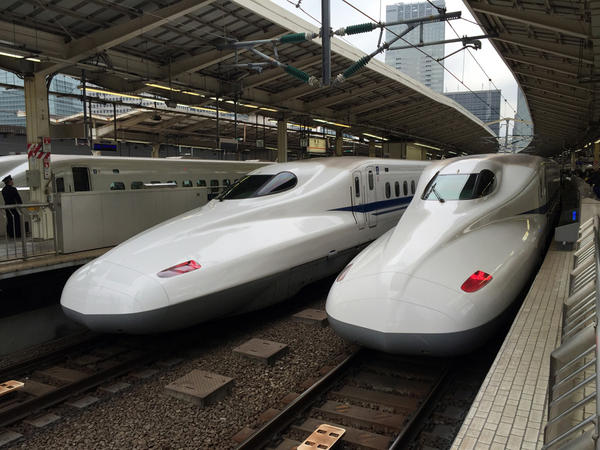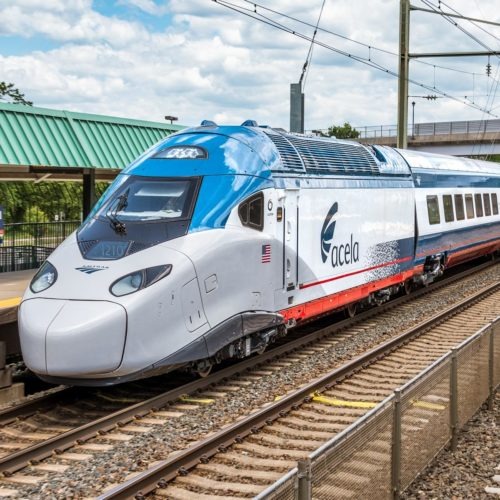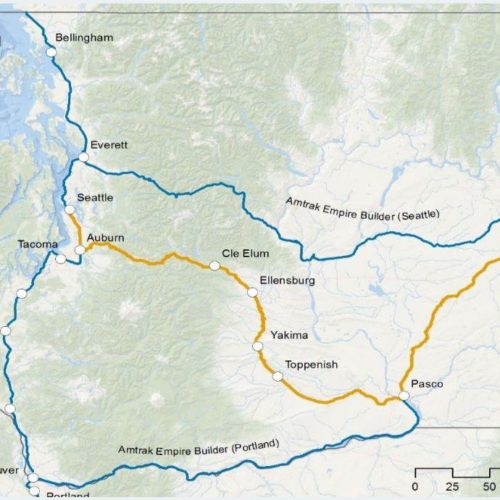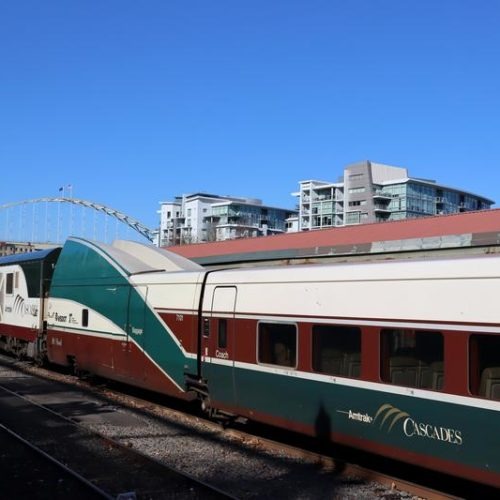
Cascadia Bullet Train Proposal For I-5 Corridor Urged On Despite Electorate’s Anti-Tax Mood
Read On
Washington voters’ apparent mood to roll back car registration fees (as of initial election returns) has scrambled transportation budgets. But Pacific Northwest rail advocates are undeterred in pursuing their vision of a bullet train connection between Portland, Seattle and Vancouver, Canada.
Microsoft hosted a high-power meeting of state policymakers, train manufacturers and rail supporters at the software giant’s headquarters Thursday in conjunction with the U.S. High Speed Rail Association. At the Cascadia Rail Summit, enthusiasm to build a bullet train capable of going from Seattle to Portland — or to Vancouver — in one hour rubbed against an anti-tax message from the passage of Washington Initiative 976.
After bemoaning that the state’s highways, bridges, ferries and rail cars “are on a glide path to failure,” Washington State Department of Transportation Secretary Roger Millar laid out the case for building an ultra-high speed railway on dedicated track.
“As we regroup here in Washington state and think about investing $50 billion in ultra-high speed rail,” said Millar, “do you think we’ll ever get to a place where highway expansion keeps up with economic expansion and population? It will not happen. It cannot happen.”
Millar estimated a cost of about $108 billion to add one additional lane to Interstate 5 in each direction from the Oregon border to the Canadian border.
“$108 billion and we’ve got another lane of pavement in each direction and it still takes you all day to get from Portland to Vancouver,” he told the audience. “Half of that invested in ultra-high speed rail and it’s two hours. That’s game changing stuff.”
Washington Gov. Jay Inslee added his endorsement of high speed rail in a video-taped message played at the conference. Democratic state Senator Marko Liias, who was in attendance, said he doesn’t see the anti-tax mood of the electorate as a setback.
“We’re going to rely on new tools like public-private partnerships, interjurisdictional cooperation with the B.C. government — maybe with the Canadian federal government,” Liias said in an interview. “We’ll clearly need federal partners here in the U.S.”
“I don’t see Tuesday’s election as a reflection on the viability of this project,” added Irene Plenefisch, director of government affairs for Microsoft, in a separate interview.
Oregon, Washington, British Columbia and Microsoft are currently cooperating on a study of governance and funding options. That study follows up on a business case analysis delivered this summer, which judged the project as viable and conservatively estimated ridership of at least 1.7 million passengers per year.
Neither the states nor the province are committed to actually building a high speed train at this point. The vision painted by the feasibility studies entails trains travelling at speeds up to 250 mph on a newly-acquired right-of-way that features extensive tunneling and elevated trackway.
We do know car tabs will not work to pay for it, quipped a strategic consultant during a panel discussion. Lots of other financing ideas were tossed out Thursday including revenue sharing from a possible carbon tax, congestion pricing, business partnerships or special property tax assessments on development around future stations.
“This is going to be a huge lift,” Democratic state Rep. Jake Fey, the chair of the House Transportation Committee, told the conference audience.
The ranking Republican on Fey’s committee, state Rep. Andrew Barkis, suggested to invest in upgrades to the existing regional Amtrak service to achieve higher speeds and frequency.
“In the short and medium term, prioritize Amtrak Cascades at a fraction of the cost and get similar results,” Barkis said in an interview.
The current Amtrak Cascades service maxes out at 79 mph and runs on tracks owned and heavily used by freight railroads.
Related Stories:

Cascadia High-Speed Rail: Will It Finally Happen Or Is It ‘Time To Kill This Thing’?
A new government report on high speed rail in the Pacific Northwest recommends that Oregon, Washington and British Columbia formalize their interest in a Cascadia bullet train by creating an independent body to plan and eventually build it. But a critic associated with a conservative think tank responded that the region should take heed of California’s high speed rail woes and put a spike in the Cascadia bullet train ambitions.

Study Estimates High Costs, Low Ridership If Washington Boosted East-West Train Service
The Washington Legislature commissioned the $250,000 study last year to see if it would be feasible to restart passenger service on the Stampede Pass line. The route crosses the Cascade Mountains from Seattle to Ellensburg, then stretches onward through the Yakima Valley to Pasco and Spokane.

Plans To Beef Up Amtrak Cascades Service Still Delayed Two Years After Fatal I-5 Derailment
A holiday wish of many Pacific Northwest rail fans is more roundtrips on the Amtrak Cascades schedule with greater speed and reliability. But in order to beef up train service between Seattle and Portland, a bypass route south of Tacoma needs to be reopened. There is still no fixed date to return Amtrak trains to those tracks where a deadly derailment happened just over two years ago.















